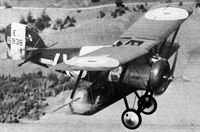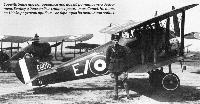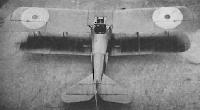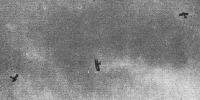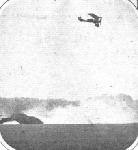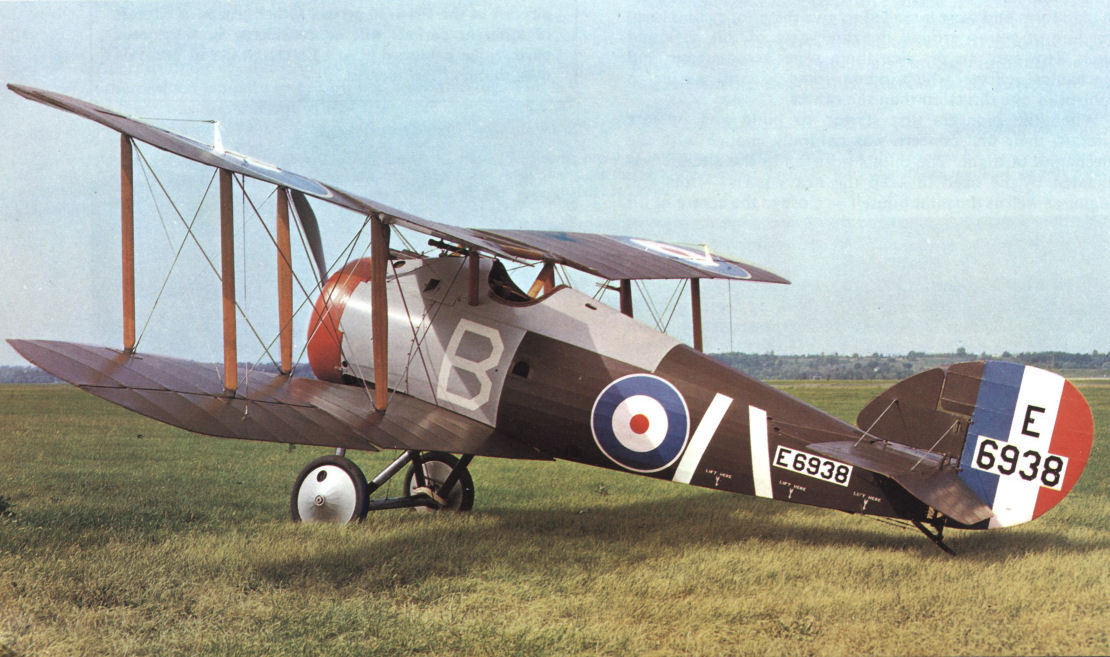
Описание
Страна : Великобритания
Год : 1918
Одноместный истребитель и штурмовик
Варианты
- Sopwith - Buffalo - 1918 - Великобритания
- Sopwith - Dragon - 1918 - Великобритания
- Sopwith - Salamander / T.F.2 - 1918 - Великобритания
- Sopwith - Snipe / 7F.1 - 1918 - Великобритания
Sopwith 7F.1 Snipe
Проектирование преемника истребителя Camel велось вокруг нового ротативного мотора Bentley B.R.2 мощностью 230 л. с. К моменту завершения постройки первого прототипа 7F.1 Snipe мотора B.R.2 еще не было, поэтому в первый полет в 1917 году прототип отправился с двигателем B.R.1 мощностью 150 л. с.
Мотор B.R.1 являлся одним их альтернативных двигателей Camel и неудивительно, что с таким мотором прототип 7F.1 Snipe не сильно отличался внешне от Camel. Однако под установку гораздо более мощного мотора конструкция планера была значительно усилена.
За первым последовали второй и третий прототипы с вертикальным оперением (небольшой киль и руль направления с роговым компенсатором), измененным для повышения путевой устойчивости. Количество межкрыльевых стоек увеличили с четырех до восьми, а размах крыла увеличили, чтобы можно было разнообразить состав вооружения. Пришлось построить и еще два прототипа, прежде чем Snipe Mk I пошел в серию. Испытания также проходил Snipe, вооруженный в дополнение к двум штатным носовым синхронным пулеметам Vickers и пулеметом Lewis, но от него отказались. Один из прототипов в феврале 1918 года доставили во Францию, летавшие на нем летчики с восторгом отзывались о новом истребителе. На вооружение британских ВВС Snipe поступил в конце лета 1918 года. Полетным данным Snipe мало отличался от Camel, но, сохранив маневренность предшественника, был более простым в пилотировании. Было заказано более 1800 истребителей, но до окончания войны в ноябре 1918 года успели построить только 100, которые поступили на вооружение четырех британских эскадрилий и одной австралийской.
За короткую боевую карьеру в Первую мировую войну Snipe зарекомендовал себя отличным истребителем. На Западном фронте Snipe стал лучшим в своем классе, летчики лишь за четыре дня сбили на Snipe 36 самолетов противника (в том числе 13 за один день). Эпический бой на Snipe провел майор У. Г. Баркер. В одиночку 27 октября 1918 года он сбил двухместный германский самолет и два истребителя Fokker D.VII.
Серийный выпуск Snipe прекратили в 1919 году после постройки 497 самолетов. В течение нескольких послевоенных лет Snipe оставался почти единственным истребителем, состоявшим на вооружении британских эскадрилий, дислоцированных в метрополии. Snipe были вооружены 11 эскадрилий, базировавшихся в Великобритании и еще четыре "заморские" эскадрильи. В 1920-1922 годах ПВО Великобритании обеспечивала единственная 25-я эскадрилья, на вооружении которой состояли Snipe.
На вооружении эскадрилий метрополии Snipe продержались до августа 1926 года, когда их сменили самолеты Gamecock, а через три месяца Snipe сняли с вооружения частей, дислоцированных в Ираке. Двухместные варианты использовались в летных школах до 1928 года.
ТАКТИКО-ТЕХНИЧЕСКИЕ ХАРАКТЕРИСТИКИ
Sopwith 7F.1 Snipe Mk I
Тип: одноместный истребитель и штурмовик
Силовая установка: один 9-цилиндровый ротативный мотор Bentley B.R.2 мощностью 230 л. с. (172 кВт)
Летные характеристики: максимальная скорость на высоте 3050 м - 195 км/ч; время набора высоты 3050 м - 9 мин 25 с; практический потолок 5945 м; продолжительность полета 3 ч
Масса: пустого 595 кг; максимальная взлетная 916 кг
Размеры: размах крыльев 9,17 м; длина 6,02 м; высота 2,67 м; площадь крыльев 25,08 м2
Вооружение: два синхронных 7,7-мм пулемета Vickers в носовой части фюзеляжа; до четырех 11-кг бомб на внешней подвеске под фюзеляжем
- Описание
Фотографии
-
АвиаМастер 1999-03 / В.Куликов - Славяно-британский авиакорпус на севере России /Белое дело/ (2)
Регистрационный номер: E6350 Сопвич "Снайп", на котором 1 августа 1919г. погиб А.А.Козаков.
-
Мировая Авиация 240
Регистрационный номер: E6809 Этот Snipe (E6809) проходил службу в 56-й эскадрилье. В 1920-1922 годах эта эскадрилья дислоцировалась в Египте, а затем принимала участие в обеспечении полицейских операций против восстания в Константинополе. В конечном итоге эскадрилья на самолетах Snipe обеспечивала ПВО Великобритании.
-
Aeroplane Monthly 1979-01 / Sopwith 7F.1 Snipe /Preservation Profile/ (69)
Регистрационный номер: E6938 [10] -
Aeroplane Monthly 1979-12 / Sopwith 7F.1 Snipe /Preservation Profile/ (80)
Регистрационный номер: E8105 -
Мировая Авиация 91
Регистрационный номер: E8102 "Sopwith" разработала Snipe для замены Camel в частях Королевского авиационного корпуса. Машина получилась в пилотировании более простой, чем Camel.
-
Air Enthusiast 1971-09 / R.Braybrook - Biplane Era: The Flight from Reality /Fighters in the RAF/ (1)
Регистрационный номер: E8132 [2] Sopwith Snipe of No 208 Squadron (1918).
-
Air Enthusiast 1972-02 / L.Coombs - Front-office evolution (1)
Регистрационный номер: E6938 [10] "...the characteristic feature ... was the close grouping of engine, fuel, guns and pilot under the wing centre-section". The Sopwith Snipe was a typical example, the close proximity of these features to each other being clearly shown here.
-
Авиация и Космонавтика 2024-12 / В.Хвощин - Видеть дальше "буратиньего носа" (2)
Реплика истребителя Sopwith 7F1 «Snipe» дает полное представление о вырезах в задней кромке и в межлонжеронном пространстве верхнего крыла. Обратите внимание на длинную трубку оптического прицела над синхронизированными пулеметами Vickers Limited
-
Aeroplane Monthly 1974-04
The late Jack Canary restored this beautiful Sopwith Snipe. It was originally built in August 1918 and is now part of the Rockcliffe Collection, Ontario.
-
Aeroplane Monthly 1990-10 / O.Thetford, A.Lumsden - On silver wings (1)
Регистрационный номер: B9963 The second Snipe prototype, fitted with a 230 h.p. Bentley B.R.2 engine. Like the first Snipe, it had a slab-sided fuselage and a fin and rudder very similar to those of the Sopwith Camel. Originally built as a private venture, it was eventually serialled B9963.
-
Aeroplane Monthly 1990-10 / O.Thetford, A.Lumsden - On silver wings (1)
The Snipe began life more brown than silver. This is the first prototype, with narrow centre-section, single-bay wings and a 150 h.p. Bentley B.R.I nine-cylinder rotary engine. It made its first flight in the autumn of 1917.
-
Aeroplane Monthly 1990-10 / O.Thetford, A.Lumsden - On silver wings (1)
Регистрационный номер: B9965 [3] Another view of the third prototype Snipe at Martlesham. The revised centre section is apparent - compare this picture with the front view of the first prototype.
-
Aeroplane Monthly 1990-10 / O.Thetford, A.Lumsden - On silver wings (1)
Регистрационный номер: B9965 [3] The third Snipe prototype, B9965, at Martlesham Heath. The aircraft retained single-bay wings, although the centre-section was widened (note the splayed cabane struts) and had a smaller cutout than that of the earlier prototypes. The fuselage sides of B9965 were fully faired instead of flat, and a redesigned but still undersized fin and rudder were fitted. The device attached to the port interplane struts, and also visible on pictures of other Snipes on these pages, is an additional pitot tube for testing purposes. An airspeed indicator, located in the bulge, could be read from the cockpit.
-
Aeroplane Monthly 1990-10 / O.Thetford, A.Lumsden - On silver wings (1)
Регистрационный номер: B9965 [3] Third Snipe prototype B9965 with two-bay wings, fitted in January 1918 following a crash at Martlesham on December 23 the previous year. Spanning 30ft compared with the original 25ft 9in, the new wings gave the Snipe improved aileron control and better performance overall.
-
Flight 1931-06 / Flight
SOME SUCESSFUL SOPWITHS: THE SNIPE WAS ALSO A USEFUL TYPE, AND ON IT MAJOR BARKER, V.C., FOUGHT 60 GERMANS, AND SHOT DOWN 4.
-
Aeroplane Monthly 1990-10 / O.Thetford, A.Lumsden - On silver wings (1)
An early production-standard Snipe with enlarged centre-section cutout and cutaway lower cowling, but retaining unbalanced ailerons and original production fin and rudder.
-
Aeroplane Monthly 1990-10 / O.Thetford, A.Lumsden - On silver wings (1)
Регистрационный номер: B9966 [2] A freshly-painted but unmarked Snipe, possibly B9966, fitted with inversely-tapered and balanced upper ailerons.
-
Aeroplane Monthly 1976-06 / Personal album
A Sopwith 7F.1 Snipe from one of the "E" serial batches, this example carries the blue and white stripe of 32 Squadron, based at RAF Kenley in the early 1920s. The engine is a 230 h.p. Bentley B.R.2 rotary.
-
Мировая Авиация 91
Регистрационный номер: E6544 [2] E6544 построен "Coventry Ordnance Works", на самолет нанесена символика 17-й эскадрильи, последней в метрополии, эксплуатировавшей Snipe.
-
Aeroplane Monthly 1988-02 / H.Levy - Champlin Fighter Museum (1)
Регистрационный номер: E6837 The beautiful Sopwith Snipe replica built for Champlin by Richard Day of Colonia, NJ. Painted in RAF colours of the early Twenties, the aircraft is fitted with a Continental R-670 in place of the original’s Bentley B.R.2.
-
Aeroplane Monthly 1979-01 / Sopwith 7F.1 Snipe /Preservation Profile/ (69)
Регистрационный номер: E6938 [10] At the Pomona Air Fair in California, 1950
-
Aeroplane Monthly 1984-02 / F.Winstanley - Those Celluloid Flying Fools (2)
Регистрационный номер: E6938 [10] Reg Denny's Sopwith Snipe E6938. This aircraft survived and was rebuilt by Jack Canary in the Fifties and can be seen today in the National Aeronautical Collection at Rockcliffe.
-
Aeroplane Monthly 1979-01 / Sopwith 7F.1 Snipe /Preservation Profile/ (69)
Регистрационный номер: E6938 [10] -
Aeroplane Monthly 1979-01 / Sopwith 7F.1 Snipe /Preservation Profile/ (69)
Регистрационный номер: E6938 [10] On show at Cranwell, 1970
-
Aeroplane Monthly 1979-01 / Sopwith 7F.1 Snipe /Preservation Profile/ (69)
Регистрационный номер: E6938 [10] During its last flying display, Rockliffe, June 1967
-
Aeroplane Monthly 1974-04
Регистрационный номер: E6938 [10] Built by Ruston Procter & Co of Lincoln in 1918, Sopwith 7.F1 Snipe E6938 was exported to Hollywood for Reginald Denny, the film star, in 1926. After eight years painstaking restoration by the late Jack Canary it was sold to the Canadian War Museum in 1964, and is finished in the markings of No 208 Sqn, RAF. It still flies on special occasions.
-
Aeroplane Monthly 1990-11 / O.Thetford, A.Lumsden - On silver wings (2)
Регистрационный номер: E7561 [2] Snipe E7561 at Stag Lane aerodrome in 1925. Powered by a 230 h.p. Bentley B.R.2 rotary engine, the Snipe had a top speed of 121 m.p.h. at 10,000ft.
-
Aeroplane Monthly 1982-07 / P.Capon - Capon's Corner
Регистрационный номер: E7561 [2] Sopwith Snipe E7561, powered by a 230 h.p. Bentley B.R.2 engine, seen during a visit to Stag Lane in June 1925. Introduced as a successor to the Sopwith Camel in 1918, Snipes remained in service until 1926. They performed aerobatics at the 1920-26 RAF Hendon Displays and E7561 may have dropped into Stag Lane at the time of the 1925 event.
-
Aeroplane Monthly 1988-05 / Personal album. Military
Регистрационный номер: E7595 Another - rather luckier - Sopwith Snipe, this time E7595, one of a batch of 500 built by Ruston Proctor in Lincoln.
-
Мировая Авиация 91
Регистрационный номер: E6977, E7601 Единственное оставшееся в Великобритании после реформирования в 1920 году истребительное подразделение, 25-я эскадрилья, в 1922 году передислоцировали из Хокинджа в Сан-Стефано (Константинополь), Турция.
-
Мировая Авиация 97
Регистрационный номер: E8015 Еще один самолет из 300 первых Snipe постройки "Sopwith" - E8015 из 43-й эскадрильи. Снимок сделан в сентябре 1918 года. 43-ю эскадрилью первой перевооружили истребителями Snipe.
Sopwith Snipe проектировался под новый ротативный двигатель Bentley и должен был стать преемником Camel. Но только 100 Snipe успели прибыть во Францию до окончания войны. -
Aeroplane Monthly 1974-12 / Personal album
Регистрационный номер: E8057 [2] Sopwith 7F.1 Snipe E8057 in service with 70 Squadron, RAF, at Bickendorf, Germany, in 1919. The aircraft bears the striped engine cowling of “B” Flight. Powerplant was the 230 h.p. Bentley BR.2 rotary engine.
-
Мировая Авиация 91
Регистрационный номер: E8132 [2] E8132 - один из первых серийных Snipe постройки "Sopwith". Самолет несет маркировку 208-й эскадрильи, которая после окончания войны дислоцировалась в Германии. Она третьей в британских ВВС получила истребители Snipe.
-
Мировая Авиация 91
Регистрационный номер: E8230 На Snipe E8230 летал Г.Т. Муир, когда служил в 70-й эскадрилье - после войны она дислоцировалась в Бикендорфе, Германия. Базировавшиеся в Европе 70-я и 80-я эскадрильи перевооружили самолетами Snipe в декабре, но эксплуатировали они их всего несколько месяцев.
-
Air Enthusiast 2003-01 / A.Thomas - From the attic
Регистрационный номер: F2369 Snipe F2369 of 43 Squadron. The sloping bars flanking the roundel were a wartime identity marking.
-
Aeroplane Monthly 1976-04 / Personal album
Регистрационный номер: F2356, F2359, F2370 Sharing Bickendorf in 1919 was No 70 Squadron, also equipped with Sopwith Snipes and distinctively marked.
-
Aeroplane Monthly 1979-12 / Sopwith 7F.1 Snipe /Preservation Profile/ (80)
Регистрационный номер: E8100 [3] As bought by Palen from Roosevelt Field Museum, 1951.
-
Aeroplane Monthly 1979-12 / Sopwith 7F.1 Snipe /Preservation Profile/ (80)
Регистрационный номер: E8100 [3] Restored as E8100, still with Clerget engine, 1963.
-
Aeroplane Monthly 1990-11 / O.Thetford, A.Lumsden - On silver wings (2)
Регистрационный номер: H4875 Snipe H4875. The curved streaks either side of the fuselage serial are not squadron markings but the shadows of the interplane struts.
-
Aeroplane Monthly 1990-11 / O.Thetford, A.Lumsden - On silver wings (2)
Регистрационный номер: H4896 Snipe H4896.
-
Aeroplane Monthly 1990-11 / O.Thetford, A.Lumsden - On silver wings (2)
A rare photograph of a 43 Sqn Snipe, seen at Bickendorf, Germany in 1919.
-
Aeroplane Monthly 1990-11 / O.Thetford, A.Lumsden - On silver wings (2)
56 Sqn Snipes at Aboukir, Egypt, where the unit was based in 1920-22. The squadron flew Snipes from January 1920 until November 1924.
-
Aeroplane Monthly 1993-10 / G.Nelson - Sam Kinkead
Регистрационный номер: E6351, E6360 Sopwith Snipes and Airco D.H.9As in North Russia, 1919. Kinkead led a flight of Camels as B Flight of 47 Squadron.
Другие самолёты на фотографии: De Havilland D.H.9A - Великобритания - 1918
-
Aeroplane Monthly 1976-04 / Personal album
The Sopwith Snipes of ‘C’ Flight, No 43 Squadron, at Bickendorf, Cologne, Spring 1919. The application of the squadron markings to the upper wing was unorthodox, but possibly a post-Armistice embellishment. These Snipes display interesting variations of fin, rudder and aileron combinations.
-
Aeroplane Monthly 1974-09 / ??? - Hendon Pageantry 1920-37
Participators await the day's flying on the morning of July 30, 1920.
-
Aeroplane Monthly 1974-09 / ??? - Hendon Pageantry 1920-37
A corner of the aircraft park at the 1921 pageant, consisting mainly (again) of Sopwith Snipes, Bristol Fighters, Avro 504Ks.
-
Aeroplane Monthly 1979-05 / Hendon /Gone but not forgotten/ (2)
Bristol Fighters, Sopwith Snipes, a Camel, an S.E.5a, a Fokker D.VII and a Sopwith Scooter await the day's flying at the first Hendon Pageant, 1920.
Другие самолёты на фотографии: Bristol F.2A/F.2B Fighter - Великобритания - 1916Fokker D.VII - Германия - 1917RAF S.E.5 - Великобритания - 1916Sopwith Camel / F.1 - Великобритания - 1916Sopwith Scooter/Swallow - Великобритания - 1918
-
Aeroplane Monthly 1990-11 / O.Thetford, A.Lumsden - On silver wings (2)
Snipes at the Hendon Pageant in July 1921.
-
Flight 1921-07 / Flight
AT THE R.A.F. PAGEANT: A batch of Snipes
-
Aeroplane Monthly 1974-09 / ??? - Hendon Pageantry 1920-37
The start of the Relay Race. Each team flew an Avro 504K, a Bristol Fighter and a Sopwith Snipe.
Другие самолёты на фотографии: Avro Avro 504 - Великобритания - 1913Bristol F.2A/F.2B Fighter - Великобритания - 1916
-
АвиаМастер 1999-03 / В.Куликов - Славяно-британский авиакорпус на севере России /Белое дело/ (2)
Два "Де Хевилленда" и "Снайп" на аэродроме в Березнике, лето 1919г.
Другие самолёты на фотографии: De Havilland D.H.9A - Великобритания - 1918
-
Air Pictorial 1957-08 / Photos by request
Регистрационный номер: E8249 JUST AN ILLUSION. This is not a case demanding a Court of Inquiry but simply a between-the-wars trick of the R.A.F. in the Middle East to give some welcome shade to single-seaters by manoeuvring the smaller aircraft as close as possible to the bigger 'planes. This excellent example of the manoeuvre shows a first-contract (E8249), all-silver Sopwith Snipe 7F.1 (230-h.p. Bentley B.R.2 rotary radial) of No. I (Iraq) Fighter Squadron photographed at Hinaidi, Baghdad, in 1926, sheltering under the 87-ft. 4-in. span of the second production (J7922) Vickers Victoria Mk. I (two 570-h.p. Napier Lion " broad arrow" twelve-cylinder inlines) of No. 70 (Middle East) Transport Squadron, based at Hinaidi. Note the early type of Vee-fronted rudders. Victorias could carry twenty-two troops, plus two crew, and took part in many pioneer military air lifts and long-range "showing-the-Flag" exercises. The 121-m.p.h. Snipe of 1918 remained in service until the late 1920s, and was the last R.A.F. fighter to be powered by a rotary aero engine.
Другие самолёты на фотографии: Vickers Victoria - Великобритания - 1922
-
Aeroplane Monthly 1990-11 / O.Thetford, A.Lumsden - On silver wings (2)
A Snipe surrounded by RAF Halton apprentices. It bears the early form of markings for an instructional airframe, “INSTr” followed by the serial number, most of which is obscured.
-
Aeroplane Monthly 1990-11 / O.Thetford, A.Lumsden - On silver wings (2)
Регистрационный номер: E8358 Sopwith Snipe, named "Bonzo", built in 1918 and used postwar at the Central Flying School
Snipe E8358 Bonzo at the RAF Pageant at Hendon on Saturday, June 30, 1923. Flown by Flt Lt C. A. Stevens in the race for the Duke of York’s Cup (in which each team entered an Avro, a Brisfit and a Snipe), Bonzo and the Halton team were victorious. -
Aeroplane Monthly 1995-08 / Personal album. Military
Регистрационный номер: E8001 Unfortunately this Snipe cannot he identified, but it and its neighbours are of 43 Sqn, and all are early production Snipes with plain ailerons on the upper wings. This appears to be aircraft “D" of the unit, an identity earlier borne by E8001 when the squadron was at Fienvillers, and it has an underfuselage carrier for the usual quartet of 25lb Cooper bombs.
-
Air Pictorial 1957-06
This Sopwith Snipe show one of the many colour schemes used by pilots during W.W.1.
-
Air Enthusiast 1997-05 / B.Cumming - Triple DSC
Регистрационный номер: E6198 F/L Fall with chequerboard-painted Snipe E6198. The significance of the scheme is not recorded.
-
Flight 1920-07 / Flight
The Sopwith "Snipe," 200 h.p. B.R.2 (No. 5), flown in the Aerial Derby by Capt. Jordan
-
Flight 1920-07 / Flight
The Sopwith "Snipe," 200 h.p. B.R.2 (No. 7), flown by Lieut. Fall in the Aerial Derby
-
Flight 1926-07 / Flight
The Sopwith "Snipe," 200 h.p. B.R.2 (No. 6), flown by Lieut. Longton in the Aerial Derby
The Sopwith "Snipe" (B.R.2 Rotary) Of the types of aircraft in use at the end of the war, quite a number have been retained. In many cases this has necessitated "reconditioning" the machines which had been kept in stores for several years, and among the types that have been reconditioned, as well as built de novo, is the Sopwith "Snipe," a single-seater fighter with rotary engine. The introduction of more powerful radial air-cooled engines has rendered the rotary obsolete. Thus the "Snipe" is now about to disappear altogether. The only squadrons still equipped with it are: No. 1 (Fighter) Squadron, Kenley, and No. 43 (Fighter) Squadron, Henlow. -
Aeroplane Monthly 1986-08 / W.Morse - The Rotary Revolution (6)
A Ruston Proctor-built Sopwith Snipe two-seat trainer is given the Hucks Starter treatment at No 5 Flying Training School at Sealand in the Twenties. The Bentley B.R.2 engine gave the Snipe a maximum speed of about 120 m.p.h.
-
Air Pictorial 1958-01 / Photos by request
Регистрационный номер: B9966 [2] ODD MAN OUT. Before the single-seat Sopwith 7F.1 Snipe assumed its final production form the design underwent several major changes in wing and tail assembly configuration. This rare phorograph illustrates the fifth prototype (B9966) with an experimental swept tailplane to increase manoeuvrability in conjunction with the newly-adopted and later standardised horn-balanced ailerons. Note extra hinges at front spar.
-
Aeroplane Monthly 1990-11 / O.Thetford, A.Lumsden - On silver wings (2)
Регистрационный номер: E6398, E6938 [10] Built in 1918, Snipe E6398 was sold to Hollywood film star Reginald Denny in 1926. It was later restored by Jack Canary and in 1964 was sold to the Canadian National Aviation Museum. It carries the markings of 208 Sqn.
-
Aeroplane Monthly 1990-10 / O.Thetford, A.Lumsden - On silver wings (1)
Регистрационный номер: F2485 [2] The best known photograph of a Snipe in flight. Believed to have been taken over Constantinople (Istanbul) this 56 (some say 25) Squadron aircraft is equipped with bomb racks during operations in the Chanak Incident, for which the squadron was detached from Egypt in September 1922. The Snipe is probably F2485.
Introduced into service during the closing stages of World War I, the Sopwith Snipe remained as the RAF's first major post-war fighter, serving with a total of 20 squadrons. -
Aeroplane Monthly 1986-08 / W.Morse - The Rotary Revolution (6)
Регистрационный номер: F2485 [2] A Bentley B.R.2-powered Sopwith Snipe of 25 Sqn over Constantinople in 1923. The first prototype Snipe was fitted with a B.R.1; most production aircraft had B.R.2s, and two examples were fitted with the unsuccessful ABC Dragonfly radial to become the prototype Sopwith Dragons.
-
Aeroplane Monthly 1990-11 / O.Thetford, A.Lumsden - On silver wings (2)
Sopwith Snipes of No 1 Sqn flying over Iraq, The unit took delivery of its first Snipes in January 1920 and retained them until November 1926, operating from Risalpur, Bangalore and Hinaidi on police duties.
-
Aeroplane Monthly 1999-06 / D.Baker - A small matter of Kurdish incursions /Inter-war RAF/
Sopwith 7F.1 Snipe single-seat fighters of 1 Sqn over Baghdad. This was the only unit so equipped in the Middle East, and its aircraft performed effectively in the ground-attack role. The Snipes remained in Iraq until 1 Sqn disbanded in late 1926.
-
Air Enthusiast 1997-05 / B.Cumming - Triple DSC
Joe Fall leading a formation of Sopwith Snipes, possibly taken at the time of the First Aerial Pageant.
-
Flight 1920-07 / Flight
The three Sopwith "Snipes" start for their turn in the Aerial Derby
-
Flight 1920-07 / Flight
Two of the Sopwith Snipes completing the first lap in the Aerial Derby. No. 6 leading No. 5 - emphasising the absolute regularity of these fast flyers
-
Aeroplane Monthly 1990-11 / O.Thetford, A.Lumsden - On silver wings (2)
THE FIRST R.A.F. "PAGEANT," 1920: The five Sopwith Snipes shown were responsible for a very beautiful display of aerobatics in formation, in which they performed numerous evolutions in perfect unison.
Five Snipes led by Flt Lt J. S. T. Fall performed aerobatics at the RAF Pageant at Hendon in July 1920. -
Flight 1921-07 / Flight
AN EVENT AT THE PAGEANT: Event 5, formation flying by Snipes. The first two machines (at top) have executed a half-loop and are continuing their flight upside down - the other three are about to follow suit.
-
Flight 1921-07 / Flight
AN EVENT AT THE PAGEANT: Event 2, two Snipes attacking a Bristol Fighter, which was eventually "brought down in flames." The Snipe on the right is on its back, and the Bristol, in the centre, is diving out of the danger zone of the second Snipe.
Другие самолёты на фотографии: Bristol F.2A/F.2B Fighter - Великобритания - 1916
-
Flight 1921-07 / Flight
EVENT 9 AT THE PAGEANT: The attack on three Handley Page bombers by five Snipes. In the first picture the latter are seen swooping down and firing their guns, and below two of the Handley Pages are sent down "in flames." To the left Mr. Newel "escapes" from the third Handley Page, and to make certain, uses three parachutes!
Другие самолёты на фотографии: Handley Page H.P.12 (O/400) - Великобритания - 1917
-
Flight 1921-07 / Flight
AT THE PAGEANT. Event 13 - which was an unlucky number for the kite balloon. The Snipe on the left is leaving the formation to attack the balloon, and on the right the kite balloon is seen falling to the ground in flames.
-
Flight 1922-06 / Flight
AT THE R.A.F. PAGEANT: Sopwith Snipes take off for the attack on the Kite Balloon, and on the right "Rupert" descends in flames after the attack.
-
Flight 1926-07 / Flight
THE THIRD R.A.F. "PAGEANT," 1922 : A much-appreciated event on this year's programme was "bombing a tank" by four Sopwith Snipes, in which the "bombs" were clearly visible during their fall and subsequent hit.
-
Flight 1924-07 / Flight
EVENT AT THE R.A.F. PAGEANT: One of the five Sopwith "Snipes" bombing the disabled "tank."
-
Aeroplane Monthly 1974-09 / ??? - Hendon Pageantry 1920-37
A Sopwith Snipe sees off a tank at the 1924 pageant.
-
Flight 1923-07 / Flight
THE "STAR TURN" AT THE R.A.F. PAGEANT: Below, a small military post defending an important railway bridge is attacked by Arabs, and escapes on a Vickers Troop-Carrier, sent to their assistance. Sopwith Snipes attack the enemy whilst the garrison emplane, and a demolition party place charges to destroy the bridge, which, as soon as the Troop-Carriers and escort get away, blows up, as shown above.
Другие самолёты на фотографии: Vickers Victoria - Великобритания - 1922
-
Flight 1921-07 / Flight
Event 11, the Relay Race: The Kenley Snipe flying home the winner.
-
Flight 1921-07 / Flight
The Sopwith Snipe (F/O J.Oliver, A.F.C) winning the race.
-
Flight 1920-07 / Flight
R.A.F. PAGEANT: The R.A.F. mascot views the proceedings from a Snipe
-
Aeroplane Monthly 1990-11 / O.Thetford, A.Lumsden - On silver wings (2)
Регистрационный номер: E6620 Two-seat Snipe E6620. Although used mainly at FTSs, one or two of these dual-control trainers were issued to most of the Snipe fighter squadrons.
-
Aeroplane Monthly 1979-12 / Sopwith 7F.1 Snipe /Preservation Profile/ (80)
As a two-seater, owned by Jimmy Romberger, Binghampton, NY, 1932.
-
Flight 1925-03 / Flight
HAWKER ENGINEERING COMPANY: Two views in the erecting shops. The machines in course of construction are Snipe and D.H.9A's.
Другие самолёты на фотографии: De Havilland D.H.9A - Великобритания - 1918
-
Aeroplane Monthly 1983-11 / L.Coombs - Cockpits of the RAF (2)
Another shot of a Snipe cockpit shows protective leather-covered pads on the ends of the Vickers gun breeches.
-
Aeroplane Monthly 1990-10 / O.Thetford, A.Lumsden - On silver wings (1)
The "office" of a Sopwith 7F.I Snipe. In the centre is the compass, flanked by the padded butts of the twin 0.33in synchronised Vickers guns. On the left is the altimeter, and the rev. counter is on the right. Beneath the compass is the control column with twin triggers and engine "blip" switch, and behind the column is the bank indicator, or "lateral clinometer". The magneto switches are at bottom left.
-
Aeroplane Monthly 1983-11 / L.Coombs - Cockpits of the RAF (2)
The cockpit of a Sopwith Snipe.
-
Aeroplane Monthly 1988-05 / Personal album. Military
Регистрационный номер: F2483 Sopwith Snipe F2483 was photographed after an unfortunate incident near Biggin during 1924. Succeeding the Camel, the Snipe remained in RAF service until 1926.
-
Aeroplane Monthly 1995-08 / Personal album. Military
Регистрационный номер: E8057 [2] This overturned Sopwith Snipe is E8057 of 70 Sqn, conspicuously marked with the three white hands round the rear fuselage that were the unit's identifying marking, plus the stripes on the engine cowling that 70 Sqn affected after the Armistice. Apparently E8057 was repaired and returned to service, for it has been attributed at a later date to 4 Sqn, Australian Flying Corps.
-
Aeroplane Monthly 1979-12 / Sopwith 7F.1 Snipe /Preservation Profile/ (80)
Регистрационный номер: E8100 [3] The end of E8100, August 28, 1966.
-
Aeroplane Monthly 1974-12 / Personal album
Регистрационный номер: E8321 Another Snipe; this time E8321, “N”, carrying the sloping bars of 43 Squadron, RAF, on fuselage and wing centre section. Apparently the pilot escaped serious injury when the aircraft crashed on landing.
-
Мировая Авиация 34
Победный полет Бейкера. 27 октября 1918г.: канадский майор У. Г. Бейкер, приписанный к 201-й эскадрилье RAF на Западном фронте, патрулируя на своем Sopwith Snipe над лесом Мормаль, заметил немецкий разведчик. Бейкер атаковал его сзади и сбил, но его самого атаковал снизу Fokker D.VII. Получив пупю в правое бедро, пилот ввел самолет в штопор, имитируя фатальное попадание. Выровняв машину, он обнаружил, что находится среди группы из 15 вражеских аэропланов. Он немедленно атаковал, сбив второй самолет. Затем зашел в хвост еще одного самолета и сбил его. Почти сразу вторая пуля попала в его левое бедро. От болевого шока Бейкер потерял сознание. Очнувшись, он обнаружил, что его Snipe окружен самолетами другого немецкого патруля. Отважный канадец сбил еще один немецкий истребитель, но третья пуля попала ему в левый локоть, Бейкер вновь лишился чувств и пришел в себя на высоте 3660 м, где его дымящий Snipe все еще был окружен самолетами противника. Бейкер попытался таранить ближайший Fokker, однако тот уклонился. Тогда летчик решил оторваться от врага в крутом пикировании и ему это удалось. Истекая кровью, Бейкер все же посадил свой изрешеченный истребитель. Он выжил и был награжден за этот бой Крестом Виктории.
Другие самолёты на фотографии: Fokker D.VII - Германия - 1917
-
Авиация и Космонавтика 2022-07 / Aviation Art от первого лица
«Когда цели не надо искать». Работа 2021 года
-
Aeroplane Monthly 1999-06 / D.Baker - A small matter of Kurdish incursions /Inter-war RAF/
MICHAEL ROFFE’S painting shows Sopwith Snipes of No 1 Sqn over typical Middle East terrain.
-
Aeroplane Monthly 1976-11
Sopwith Snipe No 56 Squadron RAF 1923
-
Aeroplane Monthly 1990-10 / O.Thetford, A.Lumsden - On silver wings (1)
Two illustrations from the RAF manual on the Snipe: left, the forward fuselage; right, the rear fuselage showing the tailskid and tailplane incidence-adjusting gear.
-
Aeroplane Monthly 1990-10 / O.Thetford, A.Lumsden - On silver wings (1)
Another illustration from the RAF manual for the Snipe, showing the bare fuselage frame.
-
Aeroplane Monthly 1990-11 / O.Thetford, A.Lumsden - On silver wings (2)
Регистрационный номер: E6268, E6544 [2], E6942, E6964, E7528, F2351, F2441 Sopwith Snipe squadron colours. Key to sketches: A Snipe F2351 of 70 Sqn, whose aircraft retained their P.C.10 finish until January 1920, when the unit disbanded. B E6964 of 56 Sqn. C E6942 of A Flight, 3 Sqn. D E6268 of 32 Sqn; Type B roundels used owing to night-flying duties. E E7528 of 25 Sqn. F E6544 of 17 Sqn. G F2441 of 111 Sqn.
-
Мировая Авиация 240
Sopwith Snipe
Тип фотографий
- Все фото (107)
- Боковые проекции (6)
- Цветные фото (3)
- Ч/б фото (78)
- Кабина (3)
- Обломки (4)
- Рисунки, схемы (13)
























